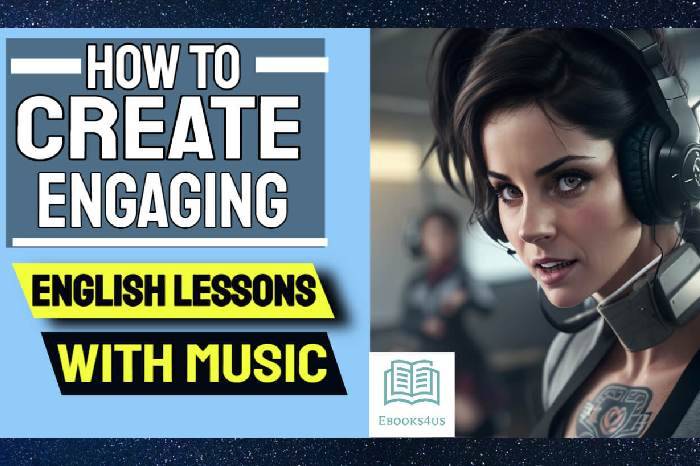How to Create Engaging English Lessons with Music

Learning English, as we all know, can be a challenging endeavor. However, I believe, as I'm sure many of you do too, that music holds the power to make language learning a fun, engaging, and memorable process. Picture this: students humming along to catchy tunes while they unconsciously internalize English syntax, vocabulary, and cultural nuances. Sounds like an exciting and effective way to learn, doesn't it? In this guide, we'll walk through the steps to creating English lessons that are not just informative, but also innovative and deeply captivating. So, grab your headphones and let's embark on this melodious journey together!
Step 1: Choose the Right Song
Your first, and perhaps the most crucial step, is to select a song that strikes a chord with your students' English proficiency levels and interests. The significance of this cannot be overstated. It's a bit like preparing a meal: the right ingredients can create an unforgettable dish, but the wrong ones can spoil the entire experience. Here are a few things to consider while picking the perfect song for your English lesson:
Language Level:
Selecting the appropriate language level for your students is like finding the perfect key to unlock their potential. We want to pose a challenge, sure, but it's essential to ensure that our students aren't overwhelmed. After all, there's a fine line between challenging and disheartening. The song you choose should have vocabulary and grammatical structures that match your students' language level. Think of it as providing a ladder they can comfortably climb, without too many rungs missing or being placed too far apart.
For beginners, consider songs that feature repetitive and simple lyrics. This repetition reinforces language learning and allows them to comfortably familiarize themselves with new words and phrases. Think nursery rhymes, simple pop songs, or folk tunes with repeated refrains. Remember, the goal here is to create a safe, enjoyable environment where students aren't intimated by the complexity of the song. It's like teaching a child to swim in the shallow end before venturing into deeper waters.
On the other hand, for more advanced learners, songs with complex language and intricate lyrical structures can provide a stimulating challenge. These students are ready to swim in the deep end, to dive into songs that contain complex metaphors, intricate storytelling, or unique wordplays. They have already built a strong foundation in the language and are ready to explore its nuances. Imagine using a song like Bob Dylan's "Blowin' in the Wind" or Radiohead's "Karma Police" for an advanced class. These songs can open up rich discussions about societal themes, abstract ideas, and advanced language structures.
Themes and Topics:
The song selection process goes beyond just linguistic complexity. A significant aspect to consider is the alignment of the song's theme or topic with your lesson. Think of it as choosing a fitting soundtrack for a movie scene—it should blend seamlessly with the story, enhancing the overall narrative.
For instance, if you're teaching a unit about the environment, selecting a song that deals with environmental issues would be an excellent fit. Imagine using songs like Michael Jackson's "Earth Song" or Marvin Gaye's "Mercy Mercy Me (The Ecology)" in a lesson about environmental conservation. The lyrics of these songs echo the urgency of the environmental crisis, providing students a new perspective and a creative way to engage with the topic.
Connecting the song to your lesson's theme facilitates a richer, more integrated learning experience. It creates a cohesive narrative that can make the lessons more meaningful and memorable. Moreover, it enables students to relate to the language in a context that they understand, making the learning process more effective.
Cultural Context:
If language is the body of communication, culture is its soul. Understanding a language outside of its cultural context is like trying to understand a book by just reading its summary. It might give you the gist, but you miss out on the depth and richness of the full story.
Don't overlook the power of music in offering students valuable insights into different cultural contexts. By choosing songs that reflect the culture of English-speaking countries, we're helping students cultivate a deeper understanding of the language within its social and cultural landscape. For example, using songs from genres like country, blues, or hip-hop can offer students glimpses into the American culture. Similarly, British pop or Australian indie music can offer insights into the cultures of those countries.
Consider using songs that narrate cultural events, historical moments, or songs that have sparked social changes. These can be great conversation starters, sparking discussions not just about the language, but also about cultural nuances, historical events, or societal changes. This approach reinforces the idea that learning a language isn't just about understanding its syntax or vocabulary, but also appreciating its cultural backdrop.
Step 2: Set Clear Learning Objectives
After selecting a song that fits like a glove, we need to identify our learning objectives. It's like plotting a map for our musical journey. What do you aspire for your students to learn from this exercise? Do you aim to expand their vocabulary, practice specific grammatical structures, or sharpen their listening skills? Having clear learning objectives will guide your lesson planning, ensuring your activities are targeted, effective, and beneficial for your students.
Step 3: Design Engaging Activities

This step is where your creativity gets to shine. With the song selected and the learning objectives established, the stage is set for you to devise engaging activities that facilitate learning while maintaining a high fun quotient. Let's look at some suggestions:
Music Video Storytelling:
For this engaging activity, we'll be incorporating some Sherlock-style detective work! Start by presenting your students with the music video of the selected song, but here's the twist: play it without the sound. Ask them to carefully observe the visuals, the actors, the settings, and the actions taking place. Based on these visual clues, have them predict the story or message of the song. It's a test of imagination and an exercise in storytelling where they craft a narrative using the silent scenes in front of them.
After they've shared their predictions, play the song with the lyrics. Let them compare their imagined narratives with the actual lyrical content of the song. Did the visuals accurately represent the lyrics? Were there surprising discrepancies? This comparative exercise not only encourages creativity but also sharpens their inference skills, drawing their attention to the non-verbal cues in communication. Plus, it brings in a visual component that caters to students who learn best through visual input.
Song-Based Debate:
There's nothing like a good debate to get the intellectual juices flowing. For this activity, choose a song that's loaded with a theme or subject that's ripe for discussion, or perhaps even a bit controversial. After a careful listening exercise, ignite a class debate based on the theme of the song.
Imagine using John Lennon's "Imagine" to spark a debate on utopian societies, or Bob Marley's "Get Up, Stand Up" to discuss individual rights and social justice. By tying the debate topic to a song, you're giving the students a concrete, creative base from which to explore and formulate their arguments.
This exercise promotes critical thinking, as students will have to analyze the song, form an opinion, and defend it. It enhances their public speaking and active listening skills and creates a dynamic, interactive learning environment that encourages open communication and respect for diverse opinions.
Lyrical Artistry:
Songs aren't just melodies set to words; they're pieces of art echoing with literary elements. Treat the song as a poem, inviting students to dive deep into the lyrics, hunting for metaphors, similes, personifications, allusions, or any other literary devices hiding in the verses.
Once they've found these literary treasures, they can share their findings and interpretations with the class, maybe even identifying how these devices enhance the song's overall message. This approach not only improves their language and literary skills but also deepens their appreciation for literature, bolsters their creativity, and makes them active participants in the journey of textual analysis.
Virtual Concert Review:
Welcome to the world of music criticism! In this activity, the students get to wear the hat of a music critic. They'll imagine that they've attended a live concert by the singer or band whose song you've been working with in class.
Based on their imaginative experience, they'll write a review discussing the performance, the artist's engagement with the audience, the set design, the atmosphere, and of course, how well the artist performed the specific song studied in class. Encourage them to use descriptive language and a rich variety of adjectives to paint a vivid picture of their 'concert experience.'
This activity offers students a chance to practice their descriptive writing skills, experiment with adjectives, and engage their creative faculties in crafting an imaginary yet believable concert experience.
Lyric Role-Play:
Let's take learning off the page and put it on the stage! Based on the song lyrics, students can create and perform short skits or dialogues. By taking on the roles of the song's characters or embodying its themes, they're not just learning the language, they're immersing themselves in it, giving it life through their performances.
Maybe they'll enact the narrative of Adele's "Hello" or embody the youthful rebellion in Taylor Swift's "We Are Never Ever Getting Back Together." Through role-play, students can explore language in context, improving their pronunciation, intonation, and understanding of conversational English.
This activity is a booster for creativity and teamwork, as students collaborate to craft their performance. Moreover, it makes the language learning experience interactive, engaging, and incredibly memorable, letting students see the practical use of language in real-life scenarios.
Step 4: Implement Tech Tools

We're teaching in the digital age, so why not embrace it? Technology can significantly enhance your song-based lessons, making them more interactive and engaging. You might use lyric videos or karaoke versions for students to follow along, or even apps that slow down the song to aid comprehension. Consider platforms like Kahoot or Quizlet for interactive games or quizzes based on the song's vocabulary or grammar. The potential to incorporate tech in your classroom is immense, so explore and experiment!
Step 5: Reflect and Evaluate
Once the musical dust has settled and the lesson is over, it's time to reflect on its effectiveness. Did your students meet the learning objectives? Were they actively engaged? Did they seem to enjoy the activities? Use student feedback and your own observations to refine and polish your future lessons.
In conclusion, integrating music into English lessons is like adding a dash of magic. It turns language learning into an engaging, exciting, and memorable journey. If this guide has sparked your interest and you're eager for more innovative ideas, I'd recommend our eBook "10 Song Activity Ideas for ELT." It's a treasure trove of creative ideas, flexible lesson plan templates, tech tutorials, and more to revolutionize your teaching experience. To dive deeper into this world of musical learning, follow this LINK to know more!
The rhythm is calling, are you ready to answer?
Ebooks4Us is your go-to resource for innovative and practical educational materials. With decades of combined teaching experience and a passion for transforming the classroom, our team of educators crafts eBooks designed to inspire, engage, and elevate your teaching practices. We believe in the power of creativity and the magic of learning, and we're here to help you become the unforgettable teacher your students need.

